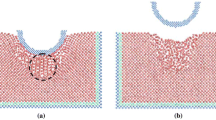Abstract
Molecular dynamics simulation is carried out to study the nanometric machining of single crystal Nickel (Ni). Through an investigation of atomic displacement and the variation of cutting force, it is found that the latter is in accordance with the number variation of elastic displaced atoms in the workpiece. It is further found that the generation of complex stacking faults is the predominant cause of cutting force fluctuation, and the stacking faults with complex structures lead to work-hardening. The temperature of the cutting tool and workpiece is studied during the machining process. It is concluded that the selection of averaging steps has a significant influence on the system temperature distribution. Thus, the time-spatial averaging method, which has a high accuracy and consistency in temperature distribution, is proposed.
Similar content being viewed by others
References
Wang B B, Wang F C, Zhao Y P. Understanding formation mechanism of ZnO diatomic chain and multi-shell structure using physical mechanics. Sci China-Phys Mech Astron, 2012; 55: 1138–1146
Deng Y C, Quan Z H, Zhao Y H. Experimental investigations on the heat transfer characteristics of micro heat pipe array applied to flat plate solar collector. Sci China Tech Sci, 2013; 56: 1177–1185
Li H F, Jia R, Dou B F. Research on ultra-small textured surface of multicrystalline silicon solar cell. Sci China Tech Sci, 2013; 56: 952–956
Chan K T, Zhao Y P. The dispersion characteristics of the waves propagating in a spinning single-walled carbon nanotube. Sci China-Phys Mech Astron, 2011; 54: 1854–1865
Fatikow S, Rembold U. Microsystem Technology and Microrobotics. Berlin: Springer, 1997
Dong L, Subramanian A, Nelson B J. Carbon nanotubes for nanorobotics. Nano Today, 2007; 6: 12–21
Fang F Z, Zhang G X. An experimental study of edge radius effect on cutting single crystal silicon. Int J Adv Manuf Tech, 2003; 22: 703–707
Fang F Z, Wu H, Liu Y C. Modeling and experimental investigation on nanometric cutting of monocrystalline silicon. Int J Mach Tools Manu, 2005; 45: 1681–1686
Alder B J, Wainwright T E. Studies in molecular dynamics. I. general method. J Chem Phys, 1959; 31: 459–466
Ji C H, Shi J, Wang Y C, et al. A numeric investigation of friction behaviors along tool/chip interface in nanometric machining of a single crystal copper structure. Int J Adv Manuf Technol, 2013; 68: 365–374
Lin Z C, Huang J C. The influence of different cutting speeds on the cutting force and strain-stress behaviors of single crystal copper during nano-scale orthogonal cutting. J Mater Process Tech, 2007; 201: 477–482
Su H, Tang Q H. Chip formation dependence of machining velocities in nano-scale by molecular dynamics simulations. Sci China Tech Sci, 2014; 57: 2426–2433
Pei Q X, Lu C, Fang F Z. Nanometric cutting of copper: A molecular dynamics study. Comp Mater Sci, 2006; 37: 434–441
Guo Y B, Liang Y C. Atomic simulation of thermal effects and defect structures during nanomachining of copper. T Nonferrous Met Soc China, 2012; 22: 2762–2770
Zhao H W, Shi C L, Zhang P, et al. Research on the effects of machining-induced subsurface damages on mono-crystalline silicon via molecular dynamics simulation. Appl Surf Sci, 2012; 259: 66–71
Lin Z C, Huang J C, Jeng Y R, et al. 3D nano-scale cutting model for Nickel material. J Mater Process Tech, 2007, 192-193: 27–36
Muhammad I, Fayyaz H, Muhammad R, et al. Dynamic characteristics of nanoindentation in Ni: A molecular dynamics simulation study. Chin Phys B, 2012, 11: 116201
Foiles S M, Baskes M I, Daw M S. Embedded-atom-method functions for the fcc metals Cu, Ag, Au, Ni, Pd, Pt, and their alloys. Phys Rev, 1986; 33: 12–15
Maekawa K, Itoh A. Friction and tool wear in nano-scale machining— a molecular dynamics approach. Wear, 1995; 188: 115–122
Tersoff J. Modeling solid-state chemistry: Interatomic potentials for multicomponent systems. Phys Rev, 1989; 39: 8–15
Kitagawa H, Konishi H, Nakatani A. Study on computational modeling for materials with crystalline structure. T Jpn Soc Mech Eng A, 1991; 57: 1986–1991
Tong Z, Liang Y C, Yang X C, et al. Investigation on the thermal effects during nanometric cutting process while using nanoscale diamond tools. Int J Adv Manuf Technol, 2014; 74: 1709–1718
Norouzifard V, Hamedi M. Experimental determination of the tool-chip thermal contact conductance in machining process. Int J Mach Tools Manuf, 2014; 84: 45–57
Author information
Authors and Affiliations
Corresponding author
Rights and permissions
About this article
Cite this article
Zhu, Z., Gong, Y., Zhou, Y. et al. Molecular dynamics simulation of single crystal Nickel nanometric machining. Sci. China Technol. Sci. 59, 867–875 (2016). https://doi.org/10.1007/s11431-016-6061-y
Received:
Accepted:
Published:
Issue Date:
DOI: https://doi.org/10.1007/s11431-016-6061-y



